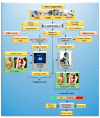Economics of Artificial Intelligence in Healthcare: Diagnosis vs. Treatment
- PMID: 36554017
- PMCID: PMC9777836
- DOI: 10.3390/healthcare10122493
Economics of Artificial Intelligence in Healthcare: Diagnosis vs. Treatment
Abstract
Motivation: The price of medical treatment continues to rise due to (i) an increasing population; (ii) an aging human growth; (iii) disease prevalence; (iv) a rise in the frequency of patients that utilize health care services; and (v) increase in the price. Objective: Artificial Intelligence (AI) is already well-known for its superiority in various healthcare applications, including the segmentation of lesions in images, speech recognition, smartphone personal assistants, navigation, ride-sharing apps, and many more. Our study is based on two hypotheses: (i) AI offers more economic solutions compared to conventional methods; (ii) AI treatment offers stronger economics compared to AI diagnosis. This novel study aims to evaluate AI technology in the context of healthcare costs, namely in the areas of diagnosis and treatment, and then compare it to the traditional or non-AI-based approaches. Methodology: PRISMA was used to select the best 200 studies for AI in healthcare with a primary focus on cost reduction, especially towards diagnosis and treatment. We defined the diagnosis and treatment architectures, investigated their characteristics, and categorized the roles that AI plays in the diagnostic and therapeutic paradigms. We experimented with various combinations of different assumptions by integrating AI and then comparing it against conventional costs. Lastly, we dwell on three powerful future concepts of AI, namely, pruning, bias, explainability, and regulatory approvals of AI systems. Conclusions: The model shows tremendous cost savings using AI tools in diagnosis and treatment. The economics of AI can be improved by incorporating pruning, reduction in AI bias, explainability, and regulatory approvals.
Keywords: AI bias; AI explainability; AI pruning; artificial intelligence; cost-effectiveness; deep learning; diagnosis; health economics; machine learning; recommendations; treatment.
Conflict of interest statement
The authors declare no conflict of interest.
Figures


















References
-
- Unwin H.J., Hillis S., Cluver L., Flaxman S., Goldman P.S., Butchart A., Bachman G., Rawlings L., Donnelly C.A., Ratmann O. Global, regional, and national minimum estimates of children affected by COVID-19-associated orphanhood and caregiver death, by age and family circumstance up to Oct 31, 2021: An updated modelling study. Lancet Child Adolesc. Health. 2022;6:249–259. doi: 10.1016/S2352-4642(22)00005-0. - DOI - PMC - PubMed
-
- Bollyky T.J., Hulland E.N., Barber R.M., Collins J.K., Kiernan S., Moses M., Pigott D.M., Jr R.C.R., Sorensen R.J., Abbafati C. Pandemic preparedness and COVID-19: An exploratory analysis of infection and fatality rates, and contextual factors associated with preparedness in 177 countries, from Jan 1, 2020, to Sept 30, 2021. Lancet. 2022;399:1489–1512. doi: 10.1016/S0140-6736(22)00172-6. - DOI - PMC - PubMed
-
- Bedir S. Healthcare expenditure and economic growth in developing countries. J. Adv. Econ. Bus. 2016;4:76–86. doi: 10.13189/aeb.2016.040202. - DOI
LinkOut - more resources
Full Text Sources

